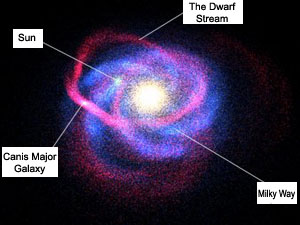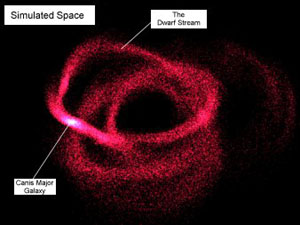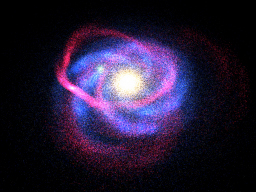Astronomers have spotted a galaxy that seems to be heading directly towards our own on a direct collision course. The international team from France, Italy, the UK, and Australia first observed the previously unknown galaxy, named the Canis Major dwarf galaxy, after analysing a survey of the sky in infrared light of the region of space demarked on star maps by the Big Dog constellation.
The newly discovered galaxy breaks the previous record for the nearest galaxy to the centre of the Milky Way. Although close in astronomical terms, the dwarf is still thankfully about 25,000 light years away from the Solar system and some 42,000 light years from the centre of the Milky Way.

Ibata
The Canis Major dwarf is not the first galaxy to be discovered on a collision course with our own. In 1994, the Sagittarius dwarf galaxy was also observed. Thankfully for life on Earth, the collision will have little direct effect as the Milky Way will simply subsume the matter from these much smaller satellites, and even then it will be many millions of years from now.
The astronomers describe their findings in detail in a forthcoming issue of the Monthly Notices of the Royal Astronomical Society (a preprint is now available). They analysed the Two-Micron All Sky Survey or 2MASS, which allowed them to see through the clouds of dust in the disk of the Milky Way that are between our telescopes and putative satellite galaxies beyond. Until now, the Canis Major dwarf lay undetected behind the dense galactic disk. It’s like putting on infrared night-vision goggles, enthuses team member Rodrigo Ibata of Strasbourg Observatory. We are now able to study a part of the Milky Way that has been previously out of sight.

The tidal forces of the Milky Way are pulling the Canis Major dwarf galaxy (here red) apart
The presence of the dwarf galaxy was betrayed by its M-giant stars - cool, red stars that shine especially brightly in infrared light. We have used these rare M-giant stars as beacons to trace out the shape and location of the new galaxy because its numerous other stars are too faint for us to see, explains Nicolas Martin, also of Strasbourg Observatory. They are particularly useful stars as we can measure their distances, and so map out the three-dimensional structure of distant regions of the Milky Way disk. In this way, the astronomers have revealed the remnants of the dwarf galaxy billion stars trailing from it as it is cannibalised by our own Milky Way.

Simulations show that over two billion years the stream of stars lost from the Canis Major dwarf galaxy wraps around the galaxy forming an immense ring of stars
The Canis Major dwarf galaxy may have added up to 1% more mass to our Galaxy, adds Geraint Lewis of the University of Sydney. This discovery highlights that the Milky Way is not in its middle age – it is still forming.

Further reading
http://xxx.lanl.gov/abs/astro-ph/0311010
Rodrigo Ibata
http://astro.u-strasbg.fr/images_ri/canm-e.html
Suggested searches
Two Micron All Sky Survey
Infrared astronomy
Milky Way